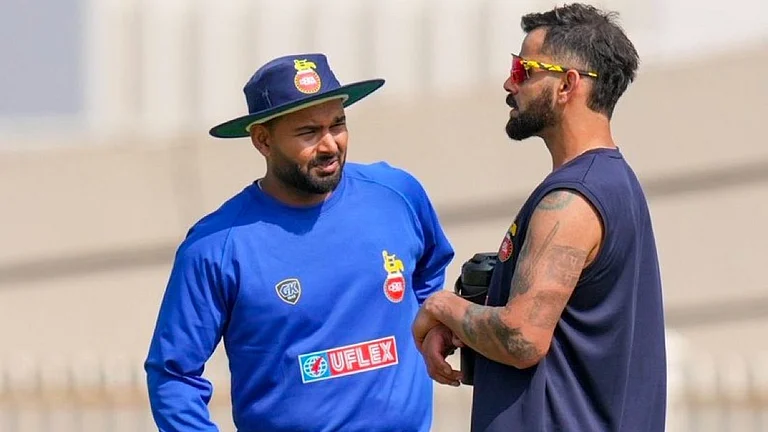Fifty-seven dry red chillies for every coconut.
That was the unusually intense spice quotient which dictated the flavour of my mother’s fish curry, which drove me out of the door during lunch. At three, one could easily throw ridiculous tantrums over spicy fish curry.
The blue door led to a common balcony on the second floor of Kailash Bhuvan, an unsung chawl in an equally nondescript lane somewhere along the Jagannath Shankar Shet road, which runs from Metro Cinema to Girgaum.
I would run out of the door, turn left and walk into the next immediate room, numbered 24, the Bandodkar home. They were Goans too from Britona. Their village is located by the Mandovi river across Panaji. Fish curries cooked in homes there are usually mildly spiced and cooked with a little bit of fresh coriander.
The Bandodkar’s room was located at one-end of the chawl. There was no river nearby like the one in their ancestral village, but in the dense and crammed overgrowth of buildings in Girgaum, the Bandodkars were privileged to have a bit of the Mumbai sky to look up at. Their room at the end of the chawl also got the most incoming breeze. Light and breeze are rare pleasures one learns to savour when you live in a Mumbai chawl.
It was from their end of the common balcony that I think I saw the first jet in flight, which left a cloud-like wake.
The Bandodkar home was anchored by a matriarch. We called her Mai. Mai had four daughters and two sons, all of whom lived in their two-room home. It was about four meters in width and around seven to eight metres in length and was identical to ours. But the fish curries cooked in both homes were far from identical.
For nearly two years, whenever my mother cooked her fish curry at home — and that was five days a week, I would sneak out to Mai’s for lunch. Mai did not have a problem. I was just another mouth to feed. There were seven others in her home.
Life in a chawl was like that, especially when you were still young. You could run out on your blood over the flimsiest of excuses and seek refuge right next door. At times, even in the midst of a running feud —feuds, when they happened, lasted for a few days to a few years— with a neighbour, children from the feuding families were still allowed to play together and walk in and out of each other’s homes even when the adults warred.
The building where our chawl was located was three-storeys tall. It’s still standing. But with crumbling concrete and a complex grid of supporting iron pillars, it has developed a sort of a mixed identity. Not unlike its inhabitants on the second floor. There were two Goan dwellers, two from Maharashtra’s Konkan and two Gujarati families.
Right down the middle of the building was a wooden staircase, under which a maid, Lakshmi, who serviced the floor, lived. She was from Andhra Pradesh.
Some 20 years ago, there was one easily understood landmark, which led to the lane where our chawl was located. A pipal tree. It was one of the only large trees along the main road, lined with old apartment blocks, older chawls, a Parsi agiary, Kala Ram temple, banks, jewellery and grocery stores. The tree was the only odd element along the concrete continuum.
Every year during Makar Sankranti, the door to Kailash Bhuvan’s terrace, otherwise routinely closed for access, was opened for everyone. It’s a day for kite-flying. It is also a dark day for the city’s pigeons, whose penchant for swift flight, led to their doom. Somehow, wily crows managed to escape death that day. The day after Makar Sankranti, one would see dead pigeons with their feet up, caught in a web of the kites’ glass power-coated strings (manja). The terrace, on festival day though, was packed with expert and amateur kite-flyers from every floor of the chawl. They warred from kite-flyers from other nearby buildings.
Security was generally a communal affair. Fastening a lock on the chawl room’s door was only reserved for long spells of absence, mostly a summer holiday visit back to the native village. Otherwise, daily and routine trips to the local market or to the garden nearby or a trip to the doctor, meant that the door was just latched. It was understood that the neighbours would be vigilant.
There was only one instance where a woman, around dawn, tried to climb up the building using a scaffolding which ringed the building for repairs. But as she was trying to swing up the ledge of the common balcony, one of the neighbours who was sleeping outside the room, raised and alarm and the intruder scampered down the way she came.
The common balcony, whose stone tiles were once black and grey was where the men of the chawl would sleep on summer nights. There were mosquitos, but I don’t remember them being vicious enough to drive us inside.
By 10-11 pm, a long line of menfolk would stretch themselves along the length of the common balcony, for the night.
A chatai served as a bed and a thin bedsheet covered the body. Sleep needed to be wrapped up by six in the morning. That was when milk and newspaper deliveries would begin, marking the beginning of the day ahead. We did not wake up to sunrise, because very little light made it to the chawl that early in the morning.
During Diwali and Christmas holidays, the long balcony was our Wankhede stadium. That’s where we played our version of test cricket. A box or plastic bins at one end of the chawl were our stumps. A single worn-out rubber chappal, placed horizontally, a few feet away was the bowlers’ mark.
Runs were automatically allotted depending on where you managed to hit the ball along the length of the chawl’s balcony. And knocking the ball, over the balcony’s ledge and onto the road below, meant you were out. And you had to go fetch the ball yourself, unless, you managed to convince some passers-by to fling the ball back up to the second floor.
Nostalgia, by its very nature tends to blur out the blips of the past. It’s a naturally-built trap, which makes the past more appealing, by erasing its rigours and unsavouriness. Some aspects of living in a chawl were unsavoury in retrospect, although it seemed the perfectly normal back then.
The common toilet for example.
There were two latrines located in a dark cavity at the head of the stairway on every floor. At night, two warm lights mildly illuminated both the toilets. Every month, the buildings’ part-time janitor would scrub the toilet’s basin with acid. Common toilets which cater to six houses and their dozens of inmates, needed a recurring splash of acid to wash the collective stains off the ceramic basin. For a few days after the janitor’s visit, a visit to the toilet was relatively tolerable.
Dalda Vanaspati, that grainy hydrogenated vegetable cooking oil, was the preferred medium for frying savouries and sweets during Diwali. Besides being cheap, it had another critical use.
Once its contents were exhausted, the empty, yellow five-litre cannisters, were ideal for carrying water to the common latrine.
Most homes in the chawl, had their own plastic Dalda cannister outside their door, mostly where they kept their footwear. They were sturdy and lasted years, not unlike the relationships fostered by communal living in a Mumbai chawl.





















